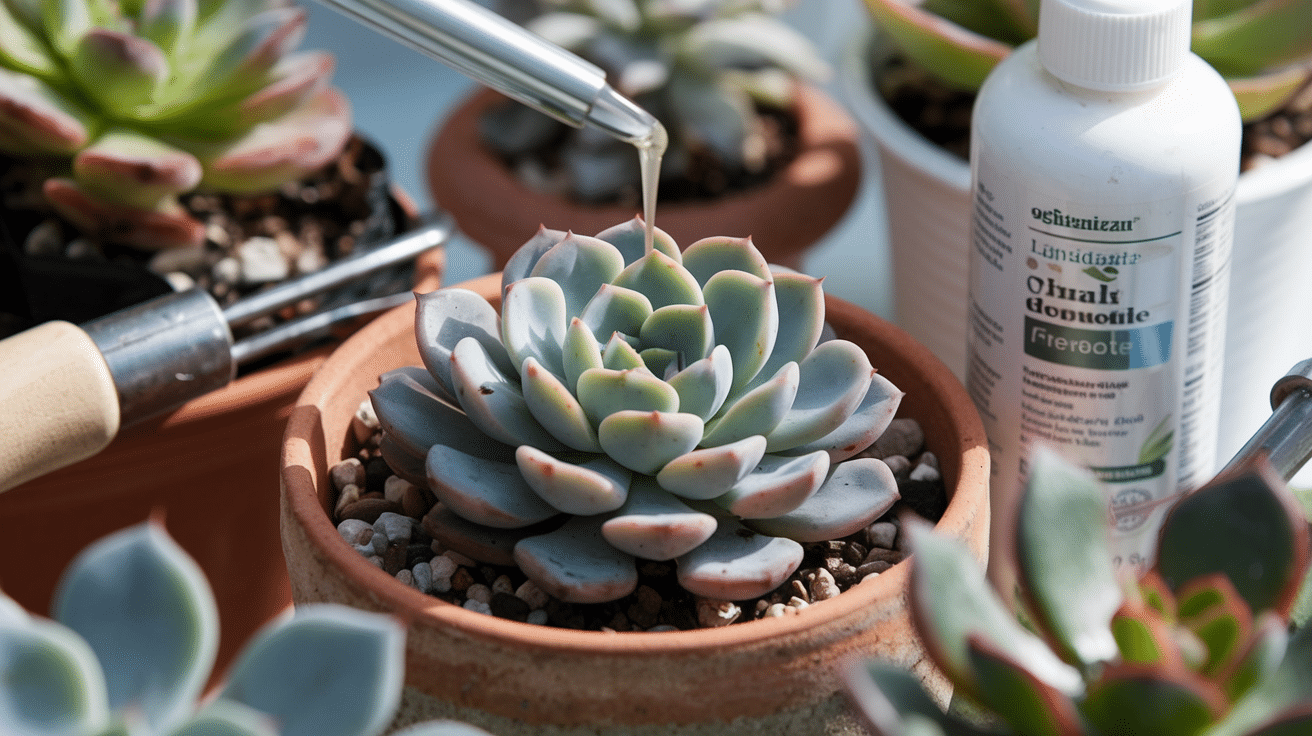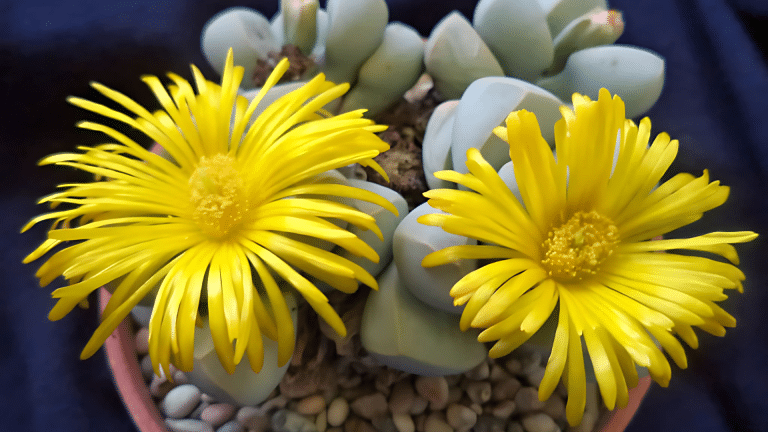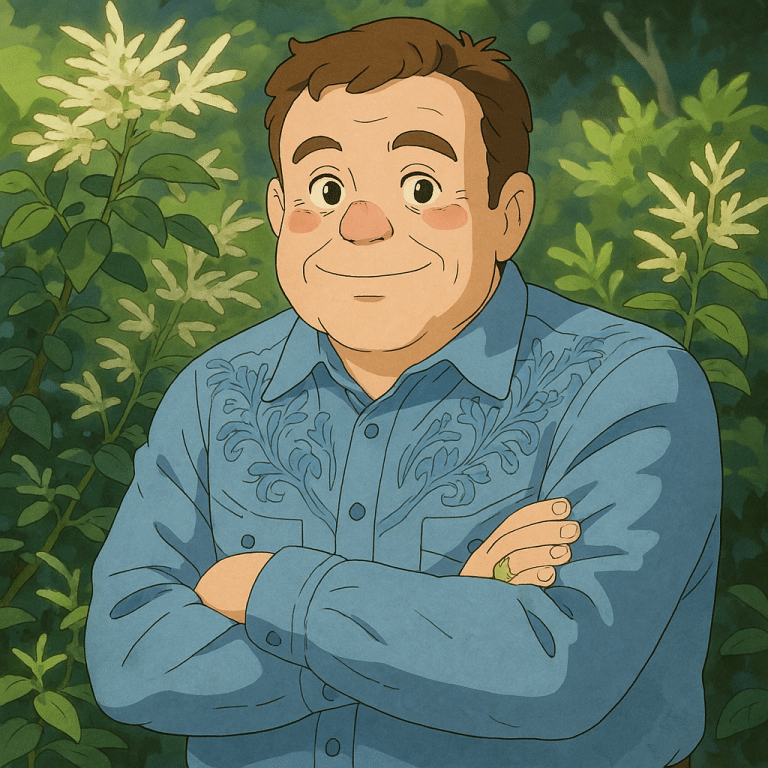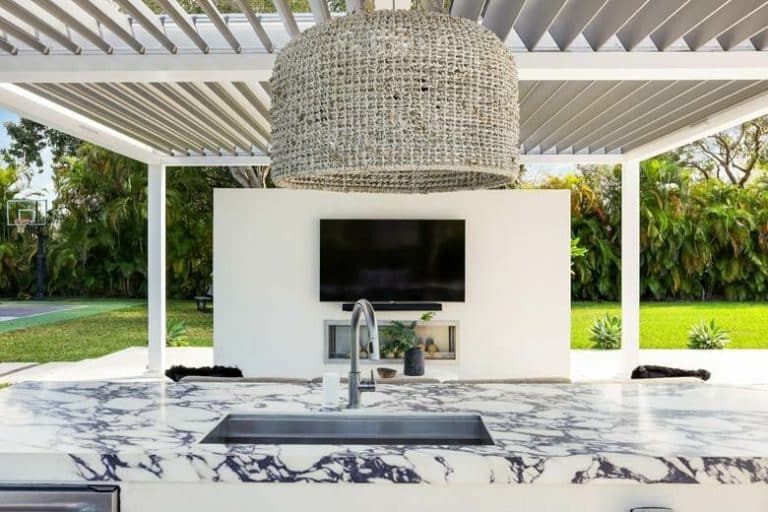Looking for a succulent that’s both unique and easy to care for? Meet the Karoo Rose (Lapidaria margaretae).
This little beauty has a stone-like appearance, making it a fun and eye-catching addition to any plant collection.
If you’re an experienced plant parent or just starting out, the Karoo Rose is perfect for you. It doesn’t require a lot of attention but still brings plenty of joy.
In this guide, we’ll cover everything you need to know to help your Karoo Rose thrive.
From simple care tips to where to place it, you’ll have all the info to keep your new plant healthy and happy.
What is Lapidaria margaretae?
Lapidaria margaretae is a small succulent that looks like a cluster of stones. It has thick, gray-green or blue-gray leaves that grow in pairs.
Each pair forms a shape that looks like a stone, which is why many people call it a “living stone” plant.
The plant stays small, usually growing only 1-2 inches tall and wide.
Native Habitat and Climate
The Karoo Rose comes from the dry regions of South Africa, specifically the Northern Cape Province.
In its natural home, it grows in rocky areas that get very little rain.
The climate there is hot and dry with cool nights. This plant has adapted to live in these tough conditions by storing water in its thick leaves.
Why it is Sought After
What makes the Karoo Rose special is its stone-like appearance and beautiful yellow flowers.
Unlike some other stone plants that can be hard to grow, the Karoo Rose is more forgiving for beginners.
It’s still quite rare in many plant shops, which makes it a prized addition to succulent collections.
Light and Temperature Needs for Lapidaria margaretae
The Karoo Rose thrives in bright, indirect light and enjoys warm temperatures.
Place it in a spot that gets plenty of sunlight, but avoid direct sun for long periods to prevent burning its leaves.
It does well in temperatures between 60°F and 85°F (15°C to 29°C), so keep it in a cozy, warm environment.
Ideal Indoor vs Outdoor Light
Your Karoo Rose needs plenty of light to stay healthy. When grown indoors, place it near a south or west-facing window where it will get at least 4-6 hours of bright light each day.
If you keep it outdoors, choose a spot that gets morning sun but some shade during the hottest part of the day.
How Much Light is Too Much?
While these plants need lots of light, too much direct summer sun can burn them.
If you see reddish or brown spots forming on the leaves, your plant may be getting too much direct sunlight.
In very hot climates, giving them some afternoon shade is a good idea.
Temperature Range and Frost Tolerance
Karoo Roses like warm temperatures between 65-80°F (18-27°C) during their growing season.
They can handle short periods of cooler temperatures down to about 40°F (4°C), but they are not frost-hardy.
If you live in an area that gets frost, bring your plant indoors during winter.
Soil and Potting Requirements
The Karoo Rose thrives in well-draining soil, ideally a cactus or succulent mix.
Choose a pot with drainage holes to prevent water from accumulating at the bottom. This will help protect the plant’s roots from rot and ensure healthy growth.
Best Soil Mix (DIY Recipe)
Lapidaria margaretae need very well-drained soil. A good mix is:
- 50% cactus/succulent soil
- 30% coarse sand or perlite
- 20% small gravel or pumice
This mix allows water to drain quickly and keeps the roots from sitting in moisture.
The Right Type of Pot
Choose a pot that is slightly wider than the plant itself but not too deep, as Karoo Roses have shallow root systems.
Clay or terracotta pots are best because they allow water to evaporate through their walls.
Most important: Make sure your pot has drainage holes at the bottom.
Soil Preparation Tips
Before potting your Karoo Rose, make sure all components of your soil mix are completely dry.
Wet soil can cause root rot when you first plant it.
Place a layer of small rocks at the bottom of the pot before adding your soil mix to improve drainage.
Watering Schedule for Lapidaria margaretae
Lapidaria margaretae is a drought-tolerant plant that doesn’t need frequent watering.
Water it only when the soil has completely dried out, typically every 2-3 weeks in warmer months.
During the winter, reduce watering further, as the plant goes into a resting phase and requires less moisture.
How Often to Water by Season
Watering correctly is the most important part of Karoo Rose care:
- Spring/Fall (growing seasons): Water only when the soil is completely dry, about once every 10-14 days.
- Summer: Water very sparingly, maybe once a month, as this is often a rest period.
- Winter: Almost no water needed, perhaps just a tiny amount once every 4-6 weeks.
Always check that the soil is completely dry before watering again.
Signs of Overwatering/underwatering
Overwatered plants will look soft and may develop translucent areas. The leaves might split or burst from too much water.
Underwatered plants will look wrinkled and may start to shrink in size.
During normal growth, some wrinkling is normal before watering.
Dormancy Behavior
Karoo Roses usually rest during the hot summer months and the cold winter.
During these times, they need almost no water. You can tell your plant is dormant when it’s not growing new leaves and looks somewhat inactive. Give water very rarely during these periods.
Fertilizer and Nutrients

The Lapidaria margaretae doesn’t need much fertilizer, but occasional feeding can help it grow well.
Use a balanced, diluted fertilizer during the growing season, typically in spring and summer.
Avoid overfeeding, as too much fertilizer can harm the plant and encourage weak growth.
When to Fertilize
Karoo Roses grow naturally in poor soil and need very little fertilizer. Many plants do fine with no added nutrients at all.
If you want to give your plant a small boost, add fertilizer only during spring (March- May) or fall (September- November) when it’s actively growing.
Once or twice a year is plenty. Skip fertilizing during summer and winter when the plant is resting.
Best Types of Fertilizer
Use only cactus/succulent fertilizer with low nitrogen content. Look for ratios like 5-10-10 on the package (the first number should be lower than the others).
Always dilute to 1/4 of the recommended strength – if the label says one teaspoon per gallon, use only 1/4 teaspoon instead.
Liquid fertilizers work well as they’re easier to control. After adding nutrients, let the soil dry completely before watering again.
Signs Your Plant May Need Nutrients
Your Karoo Rose might need a tiny nutrient boost.
If its new leaves look smaller than old ones or if the color seems pale or yellowish instead of gray-green. No new leaf pairs for over a year might also suggest a need for nutrients.
Check light and water conditions first, as these often cause problems that look like nutrient issues.
Make sure your plant gets enough light without getting sunburned, and that you’re not over or under watering.
If everything else seems right, try a small amount of diluted fertilizer. Remember that slow growth (1-2 new leaf pairs yearly) is normal and healthy for these plants.
Growth Cycle of Lapidaria margaretae
Your Karoo Rose might only grow 1-2 new pairs of leaves each year. Old leaves will slowly dry up and be replaced by new ones. This is a very slow-growing plant.
Visual Indicators of Active vs Dormant State
During active growth, you might see new leaf pairs forming in the center of the plant.
When dormant, the plant stays the same size and may look slightly more closed up or compact.
Blooming Season and Appearance
If you’re lucky, your Karoo Rose will bloom in late fall or early winter.
The flowers are yellow, daisy-like, and quite large compared to the plant’s size. They typically open in the afternoon and close at night.
How to Collect and Grow Seeds
After the flower fades, a small seed pod will form. Let it dry on the plant, then carefully collect the tiny seeds inside.
Sow them on top of moist cactus soil, cover them lightly with sand, and keep them slightly damp until they sprout (which can take 2-4 weeks).
Growing from seeds takes patience, as plants may take years to mature.
Can it be Divided?
Unlike some succulents, Karoo Roses shouldn’t be divided. They grow as a single plant with pairs of leaves, not as clusters that can be separated. The best way to get more plants is through seeds.
Common Problems and Solutions
Like any plant, the Karoo Rose can face a few common issues. Overwatering is one of the biggest challenges, leading to root rot.
Ensure the soil drains well and water only when it’s dry. Pests, like aphids, could also be a problem, but they can be easily removed with a mild soap solution.
- Some leaf splitting is normal during growth, but sudden splits mean too much water. If this happens, cut back on watering.
- Check for pests like mealybugs (white cottony spots) or spider mites (fine webbing). Please treat it with rubbing alcohol on a cotton swab.
- Yellow leaves indicate excess water or sun. Shriveling in dry soil means your plant needs water.
- Soft, black areas indicate rot from overwatering. Remove the plant, cut away bad parts with a clean knife, let it dry for a few days, and then repot it in fresh soil.
Seasonal Care Calendar for Lapidaria margaretae
The Seasonal Care Calendar for Lapidaria margaretae helps you stay on top of its needs throughout the year.
By following this simple guide, you’ll know exactly when to adjust watering, lighting, and temperature to keep your plant in top shape.
| Season | Watering | Light & Temperature | Growth & Care |
|---|---|---|---|
| Spring (Mar- May) | Start regular watering when the soil is completely dry (about every 10-14 days) | Bright light, protect from harsh midday sun. | Add a small amount of diluted fertilizer if needed; look for new leaf pairs forming. |
| Summer (Jun- Aug) | Reduce to minimal watering (once monthly or less) | Provide afternoon shade in hot areas; maintain 65-80°F (18-27°C) | Growth typically slows; this is normal and healthy |
| Fall (Sep-Nov) | Return to regular schedule when soil is fully dry (about every 2 weeks) | Full morning light; less intense afternoon sun | Look for yellow flower buds forming; this is the main bloom time |
| Winter (Dec- Feb) | Almost none (maybe once every 4-6 weeks) | Keep in bright spot but away from cold drafts; keep above 40°F (4°C) | The plant is mostly inactive; avoid moving or repotting |
Final Thoughts
Lapidaria margaretae may look tough with its stone-like appearance, but it’s actually quite easy to care for once you understand its basic needs.
Throughout this guide, we’ve covered everything from soil and light to watering and seasonal care. I hope you feel more confident about adding this unique succulent to your home.
What I love most about Lapidaria margaretae is how it teaches us patience.
In our fast-paced world, there’s something calming about a plant that grows at its own slow pace.
When it rewards you with those bright yellow flowers after months of care, the feeling is truly satisfying.
Remember, plants don’t need perfection – just consistent care with love.













